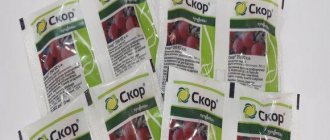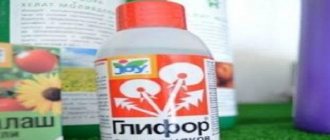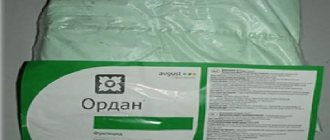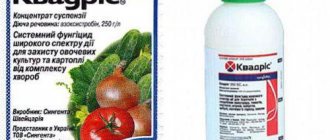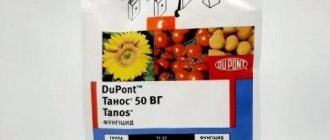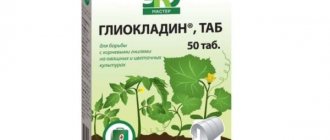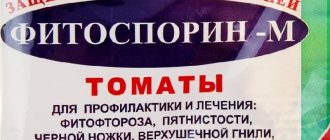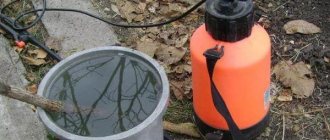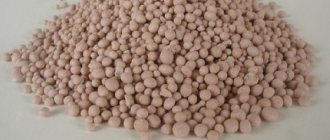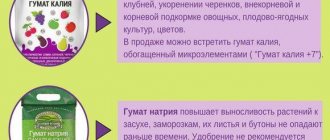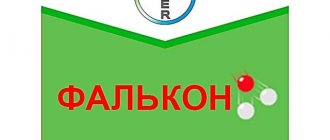Albit is a complex effective biological product, a universal plant growth regulator with the properties of a fungicide and complex fertilizer.
The drug combines three actions - plant growth regulator, antidote, fungicide:
- Growth regulator - increases resistance to drought and other stresses, increases productivity, field germination, activation of growth and development processes, and improvement of product quality.
- Antidote - neutralizes the stressful effects (of agrochemicals) on the growth and development of cultivated plants, reducing yield losses from pesticide stress, improving crop quality, reducing the retardant effect of pesticides on seed germination.
- Fungicide - immunizes the plant against diseases.
Form, composition
The preparative form of Albit is a flowable paste (TPS) with a pleasant pine smell, easily mixed with water.
The drug is packaged in plastic bottles with a capacity of 1 liter, packed in boxes of 16 liters.
Active ingredients:
- Potassium nitrate - 91.2 g/kg;
- Potassium phosphate disubstituted - 91.1 g/kg;
- Urea - 181.5 g/kg;
- Magnesium sulfate - 29.8 g/kg;
- Poly-beta-hydroxybutyric acid - 6.2 g/kg.
Strengthening the supply of nutrients to plants
Due to the proliferation of nitrogen fixers, phosphate solubilizing and other beneficial bacteria in the soil, Albit increases the utilization rates of mineral nutrition elements from soil and fertilizers by plants by 18-47%. As a result, plants use “available nutrient resources” more efficiently. According to the Department of Agrochemistry of Moscow State University, the addition of Albit can reduce the consumption of mineral fertilizers by 10-30%. On average cultivated soil, the use of Albit can replace up to 18 kg of a.m./ha of nitrogen fertilizers and 14 kg of phosphorus (VIUA Bulletin, No. 113 - 2000).
Purpose, indications for use
Albit is a modern innovative drug of biological origin “3 in 1” (antidote, fungicide, growth regulator), the purpose of which is:
- increasing plant resistance to drought and other unfavorable environmental factors (stress);
- neutralization of the stressful effects of chemical pesticides and fertilizers;
- increasing field germination of seeds;
- reducing the period required for plants to form a crop;
- increase in yield (by 5–30% depending on the crop);
- improving product quality (increases the gluten content of wheat by 0.5–5.1%);
- immunization of plants against a wide range of diseases (root rot, septoria, leaf rust, powdery mildew, net spot, bacteriosis, late blight, etc.).
Average increase in yield to control, c/ha
Albit – fungicide and growth regulator
A universal drug with complex action is created on the basis of biological cultures, which determines the multifunctionality of the product. It is officially registered in the group of fungicides, although its action is not limited to the fight against fungal diseases. Read more about what Albit is and how to use it effectively for plants.
The packaging indicates the different purposes of Albit. It's not a mistake. The drug has fungicidal, protective, immunological and regulatory properties.
How does it work?
The mechanism of action of Albit is based on stimulation of natural protective reactions of plants.
The drug interacts with the receptors of the NADPH oxidase system of plants, which stimulates the expression of a complex of antioxidant enzymes (superoxide dismutase, peroxidases, dehydroxyascorbate reductase, glutathione reductase).
Plants treated with Albit acquire increased resistance to pesticide stress, drought, extreme temperatures, frost, chemical soil pollution and other stresses.
An indicator of stress resistance of plants treated with Albit is a high chlorophyll content.
Activation of NADPH oxidase under the influence of Albit also causes the synthesis of salicylic acid, an extremely active signaling compound that immunizes plants against diseases.
As a result, plant tissues acquire nonspecific resistance to a wide range of pathogens
Drought resistance
According to the Institute of Plant Physiology of the Russian Academy of Sciences, Albit enhances the ability of plants to tolerate drought (i.e. elevated temperatures and moisture deficiency) by 10-60%. Albit is the only pesticide officially registered in Russia as a means of increasing the drought resistance of field crops (List of pesticides..., 2006). Increased drought resistance of plants persists for several months after treatment with the drug. Under drought conditions in 2003 on farms in the Krasnodar Territory, due to increased drought resistance, Albit made it possible to obtain high yields of wheat and barley (50-70 c/ha) - at the level of the non-drought year of 2002. A similar effect was noted in 1998, 2000, 2001, 2003 , 2007, 2010 dry years in various regions of Russia, as well as Ukraine, Kazakhstan and Nigeria (Southern Sahara). The main contribution to increasing drought resistance under the influence of Albit is made by the timely formation of a well-developed root system. In long-term field experiments on spring wheat, it was found that pre-sowing seed treatment with Albit reduces the moisture consumption required to form a ton of grain by an average of about 10% (Protection and Quarantine of Plants, No. 7-2011).
Instructions for use
Spraying of most crops is carried out 1-3 times in the first half of the growing season (before flowering inclusive), starting from the stage of 3-5 leaves, with an interval between treatments of 2-3 weeks.
On field crops, 1-2 sprayings are usually performed, on garden and vineyards - 2-3 sprayings per growing season. The Albit concentration used is 1-2 ml/10 l of working solution (about a third of a teaspoon per bucket of water).
This solution can be used for standard watering, root and foliar fertilizing, drip irrigation, saturation of peat mixtures and soils, however, it is required that the Albit solution must wet the plant leaves.
Since Albit is a highly active drug, the hectare dose of Albit should not exceed 300 ml/ha per spraying.
The most effective is the use of the product as an antidote in combination with planned treatments with chemical pesticides: herbicides, insecticides, fungicides and liquid fertilizers in the first half of the growing season.
If several treatments with Albit are recommended, then later treatments are carried out only if earlier treatments are carried out, as an addition to them.
Regulations for the use of the drug Albit, TPS
Wheat, barley, flax, dosages:
Beets, potatoes, grapes, cabbage:
Regulations for the use of Albit, TPS in private farming
For soaking seeds and processing seedlings
To disinfect seeds from fungal diseases, in particular from late blight and rhizoctonia, the seed is sprayed, adhering to the following standard recommendations:
| Working solution concentration | 1 g paste per 8 liters of water |
| Seed exposure time in solution | 3 hours |
The same solution is sprayed on potato tubers before germination or planting in open ground.
A working solution of the same concentration is used to treat the plant substrate for sowing seeds. Also, it is effective for preventive spraying of seedlings at the stage of two or three true leaves.
Potatoes are processed when the sprouts reach 8 cm.
As a growth stimulant
Relief of herbicide stress
Herbicides, in addition to controlling weeds, always have a stressful effect on the crop itself, which they are designed to protect. To reduce the toxic effects of stress, special substances are used - antidotes (anti-stress agents). The use of Albit as an antidote together with herbicides allows you to save up to half the harvest of grains, sugar beets, soybeans, flax and other crops. The anti-stress effect of Albit is especially pronounced when processing winter grains at the tillering stage. Plants weakened by overwintering, herbicide, and root rot respond to Albit with a sharp increase in yield (up to 10 c/ha under production conditions).
Price
The price of Albit is significantly lower than that of other similar drugs. The cost of treating 1 ton of grain seeds or 1 hectare with Albit during the growing season does not exceed 100 rubles.
The Albit application rate for most crops is 40 ml per ton of seeds for pre-sowing treatment, 40 ml/ha for spraying vegetative plants.
The full cycle of application of the drug on grain crops (pre-sowing + 2 treatments during the growing season) requires an average of 90 ml of Albit per hectare, which corresponds to 198 rubles/ha (based on the price of 2200 rubles/liter).
Combination with pesticides
To date, the antidote effect of Albit has been proven when the drug is combined with herbicides based on 2,4-D, amidsulfuron, haloxyfop-P-methyl, desmedipham, dicamba, quizalofop-P-tefuryl, clopyralide, metsulfuron-methyl, tralkoxydim, triasulfuron, tribenuron- methyl, trifluralin, triflusulfuron-methyl, phenmedipham, fenoxaprop-P-ethyl, florasulam, fluazifop-P-butyl, hisalofop-P-ethyl, chlorsulfuron and etofumesate (data from 120 field experiments). At the same time, in the vast majority of experiments (more than 95%), Albit did not reduce the effectiveness of herbicides against weeds.
Also, thanks to its antidote effect, the use of Albit together with insecticides against aphids, leech, leafmining flies, Colorado potato beetles, caterpillars and other pests can increase plant productivity by 5-93% compared to the use of a pure insecticide. On rapeseed, the use of 1 ml of Albit together with insecticides provides an additional 1.3 to 6.0 liters of oil (Plant Protection and Quarantine, No. 8-2007).
In general, when used together with fungicides, insecticides and herbicides, Albit increases the effectiveness of their use from 5 to 93% (in terms of yield increase). According to one of the managers of leading Albit consumer farms, only together with Albit did the fungicides that he had used previously begin to “work in full force,” that is, to provide 100% of the effect intended by the manufacturer and reflected in advertising. Combined use with Albit ensures reliability and high effect of using standard recommended plant protection products.
Reviews
According to reviews from those who have tried this fertilizer, the advantages include:
- Increases the yield of all major crops by 10-35%.
- Increases plant resistance to drought and other unfavorable environmental factors (stress)
- Neutralizes the stressful effects of chemical pesticides and fertilizers,
- Increases field germination of seeds
- Reduces the period required for plants to form a harvest,
- Improves product quality (increases the gluten content of wheat by 0.5–5.1%)
- Increases plant resistance against a wide range of diseases (root rot, septoria, leaf rust, powdery mildew, net spot, bacteriosis, late blight, etc.).
- Low cost.
Protection from diseases
Albit has a protective effect, inhibiting the development of a wide range of major diseases of agricultural crops (root rot, powdery mildew, leaf spot, leaf rust, fusarium, septoria, anthracnose, scab, late blight, white and gray rot, bacteriosis and others) - in total the drug is registered in as a fungicide to combat 26 plant diseases. The biological effectiveness of Albit against diseases averages 40-90% (Protection and Quarantine of Plants, No. 1-2005; Agriculture, No. 1-2007). The effectiveness of Albit against many diseases is not inferior to much more expensive chemical means of protection, which are tens of times more expensive than Albit. Thus, against root rot of grain crops, the biological effectiveness of Albit is on average 59-81%, while for chemical disinfectants it is 40-70% (Protection and Quarantine of Plants, No. 3-2005).
Unlike chemical fungicides, Albit does not have a toxic effect on pathogens, but protects plants from diseases by increasing the natural resistance (immunity) of plants. Therefore, Albit should be applied before the first signs of the disease appear and when plants are affected by a complex of infections no more than 30% (in the absence of internal infections). At a higher level of disease, it is recommended to combine the drug in tank mixtures with chemical fungicides.
Reliability
Agricultural practitioners are well aware that the results of using even highly effective drugs often vary markedly depending on the year, specific field, agricultural background, phytosanitary conditions, and timing of application. One of the goals in developing Albit was to overcome low reproducibility, a phenomenon characteristic of many biological products. Reproducibility can be quantified using the coefficient of variation (CV), the ratio of the standard deviation of data from specific experiments to the arithmetic mean. According to the average results of all field experiments, the CV of Albit is 52%, biological products and growth regulators (without Albit) - 130%, synthetic chemical fungicides - 59%. Accordingly, Albit’s ability under various conditions to provide a stable increase in yield (the inverse of CV) was 1.96 times higher than that of analogues and 26% higher than that of chemical standards. Therefore, one of the main advantages of Albit is the high reliability and reproducibility of the effect (Fig. 6).
Precautionary measures
A person familiar with TB from agrochemistry may have a question: why, does it contain a lot of urea, and is it hazard class 4? And here it remains to take off our hats to the specialists of NPF Albit LLC. They correctly identified that the main dangers of working with urea come from dusting and chipping of the dry substance. Urea itself, as a natural waste product of animals, is not particularly toxic; its permissible concentrations in human blood are:
- Children under 14 years of age – 1.8-6.4 mmol/l (108-354 mg/l).
- Adults under 60 years of age – 2.5-8.32 mmol/l (150-492 mg/l).
- Adults over 60 years old – 2.9-7.5 mmol/l (174-450 mg/l).
In the Albit TPS formation there is nothing to dust or crumble, and hazard class 4 for people is assigned to it only because class 5 (safe substance) is not assigned to agrochemicals. So, basic precautions are needed for working with the drug:
- 3-5 days before treatment with Albit, warn beekeepers in an area of 2-3 km about the upcoming use of the drug. The flight limit of bees is 6-24 hours (until the next morning departure).
- When working, use the usual personal hygiene products in the workplace (clothing that covers the body, shoes, a hat, safety glasses and gloves), supplemented with a gauze bandage.
- If the drug gets on the body, eyes or mucous membranes, rinse thoroughly with water. In the absence of signs of illness, you can continue working, changing your clothes if you get wet.
- If ingested, take 3-4 tablets or activated carbon powder with a glass of water, then another 3-4 glasses of water, induce vomiting and consult a doctor for a medical examination.
- After finishing work, take a shower. Neutralize Albit spilled on the floor with 2-4 tbsp soda solution. l. for 1 liter of water. Spilled on the ground does not require neutralization.
Note : ingestion of magnesium sulfate can cause so-called. magnesium shock and, as a result, severe diarrhea. In medicine, this effect is used in the treatment of obesity, in oncology, etc. But, if the toilet is in the yard, the “caught” may not reach it. This is perhaps the greatest possible danger to humans from Albit.
Albit storage conditions are usual for agrochemicals: in a separate non-residential premises where food products, medicines, clothes, shoes, and household items cannot be stored. Since nitrate and urea in the TPS preparative form are fire and explosion-proof, additional precautions when storing nitrogen fertilizers are unnecessary.
